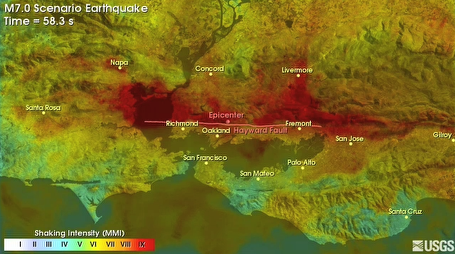Resilience: How To Deal With A Chaotic World
Posted by Big Gav in resilience
Jamais Cascio has a post at Open the Future on how diverse, resilient systems are the best way to mitigate shocks - Resilience and the Next Disaster.
If you live in the San Francisco Bay Area, have friends or loved ones who do, or simply enjoy the various products and services to be found around these parts, take heed:
When the Big One hits, it won't be pretty.
The US Geological Survey has put out a set of videos showing the shaking associated with a major earthquake on the Hayward Fault. There hasn't been a big one on the Hayward Fault in over 300 years, and it's overdue for a serious seismic event. The USGS videos cover quakes measuring 6.8, 7.0, and 7.2, with epicenters ranging from Fremont in the south to the San Pablo Bay in the north.
Short version: if you live in the Berkeley hills... well, it's not pretty. No place is truly safe -- Santa Cruz seems to come out okay -- but some places are likely to be flattened, regardless of the precise epicenter. (It's worth noting that the location of the epicenter does not correlate to the worst damage -- in fact, a quake hitting at the Fremont location is actually worse for more of the East Bay than one centered in Oakland.)
So what do you do to prepare? There are numerous good sources for earthquake advice and kits, but (as is my habit) I want to look at the broader picture.
Survival in an earthquake, generally speaking, requires much of the same kind of practices as survival in a hurricane, in a terrorist attack, or any other form of shocking hit with long repercussions. It all comes down to resilience.
Here are my key elements of a diverse system -- I'll explore each in more depth in the coming days (as my schedule permits):
Diversity: Not relying on a single kind of solution means not suffering from a single point of failure. (Prepare for different kinds of problems -- needing to escape the house, needing to stay in the house, dealing with no water, etc.)
Redundancy: Backup, backup, backup. Never leave yourself with just one path of escape or rescue. (Make sure you have multiple copies of critical documents and extra amounts of key medications.)
Decentralization: Again with the single point of failure problem. Centralized systems look strong, but when they fail, they fail catastrophically. (Don't store your emergency supplies in one location -- spread them out.)
Collaboration: We're all in this together. (Take advantage of -- and learn to use -- collaborative technologies, especially those offering shared communication and information.)
Transparency: Don't hide your systems -- transparency makes it easier to figure out where a problem may lie. (Make sure key shut-off switches -- for gas, especially -- are readily identified.)
Openness: Many eyes make all bugs shallow. Share your plans and preparations, and listen when people point out flaws. (You're safer in an emergency when everyone is safer.)
Fail Gracefully: Failure happens, so make sure that failure states don't make things worse than they are already. (Think about what'll happen when disaster strikes -- what will fall, shatter, burst into flames, and what can you do now to prevent it?)
Flexibility: Be ready to change your plans when they're not working the way you expect. Don't get locked in to a particular approach. (Pay attention to what's happening around you, and don't expect things to remain stable.)
Foresight: You can't predict the future, but you can hear its footsteps approaching. Think and prepare. (Make sure you have your emergency kit ready before the emergency hits.)
Resilience, people. That's how we deal with a chaotic world.






